Saving butterflies, moths and our environment
Celebrating our 40th Anniversary!
1982 - 2022
Brown Hairstreak egg at Shipton Bellinger. Brown Hairstreaks may look rather worn and tatty at this time of year but several remain on the wing at Shipton Bellinger. Four were seen on transect yesterday including an egg-laying female. [Posted by Clive Wood]
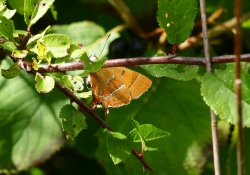 | 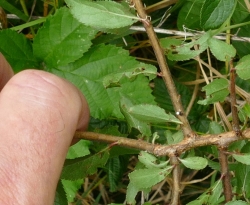 |  |
| Female Brown Hairstreak Photo © Clive Wood | Brown Hairstreak egg to right of finger Photo © Clive Wood | Basking female Brown Hairstreak Photo © Clive Wood |
Browndown North. My first trip to Browndown North and I wasn’t disappointed. Within minutes of arriving I noticed a small yellow triangle on the grass; at last my first Clouded Yellow of the year. Moving on to areas of short, sparse heather the Grayling was showing very well. Many flights, active nectaring, and best of all a pair displaying courtship behaviour. Also four large female Small Coppers were seen, all in good condition plus a great green bush cricket. A most worthwhile visit [Posted by James Clark]
Grayling - Lee on Solent. An unusual sighting today during a walk around Daedalus airfield - a Grayling on the gravel path adjacent to Ross House. First I've seen in this area and very late in the year. It also exhibited some unusual behaviour - persistently flicking its wings open for a fraction of a second. I've only ever seen an open winged Grayling before when pairing but this was a lone butterfly. A painful lesson learned - always carry my camera even on the shortest of walks! [Posted by Mark Wagstaff]
Beacon Hill NNR Field Trip. Another cloudy day with the threat of rainfall as we wandered around close to an area where there were sheep and goats keeping the sward short and sure enough there was a couple of Silver-spotted Skippers to be seen. There were small amounts of other species the best were Brown Argus and Chalk Hill Blues, mixed with a few Common Blue. No Adonis Blues were seen along with the very elusive Clouded Yellow. We saw several moths Common Carpet, The Snout, Hebrew Character, Silver-‘Y’ and several micro moths as well. But we drew stumps again quite early as the weather was cool and cloudy and made searching for butterflies very hard.? [Posted by Ashley Whitlock]
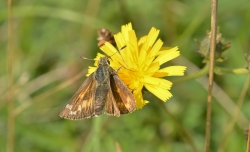 |  |  |
| Worn female Silver-Spotted Skipper Photo © Ashley Whitlock | Threat of rain was ever present... Photo © Ashley Whitlock | Female Chalkhill Blue Photo © Ashley Whitlock |
Long-tailed Blue in Havant. My second Long-tailed Blue of the year in my medium sized garden in East Street , Havant. This time a faded female laying on the buds of my sweet peas. It stayed for about 30 minutes laying many eggs. If I can have 2 separate individuals in my garden in a three week period there surely must be many around. [Posted by Alan wingrove]
Old Winchester Hill. Despite a largely overcast day, 17C and slightly breezy, it was well worth a visit to Old Winchester Hill this afternoon. At the bottom of the southern slope, where it was relatively warm and sheltered, I saw about 200 Meadow Browns, 20 female Gatekeepers, 20 fresh Small Heaths, 3 Speckled Woods, 1 Large White and 20 Small Whites. Also, 1 female Brown Argus, 3 male Common Blues, 60 mostly very faded Chalk Hill Blues, about 20 fairly fresh male Adonis Blues, and 3 female Silver-spotted Skippers, which were ovipositing at the base of grasses at the edge of rabbit scrapes.
I would have stayed longer but I stumbled across a very lively wasp nest and got chased by a swarm, escaping miraculously without getting stung. After getting my breath back I returned to the top of the slope, walked the perimeter of the ramparts and crossed over to the car park slope, but by then it was cooler and I saw nothing else apart from a Red Admiral, a handful of Meadow Browns and another Silver-spotted Skipper. [Posted by Adrian Hoskins]
Old Winchester Hill, Nr Warnford. From 1020-1250 I descended the dreaded car park slope and returned after recording 14 species including a late Dingy Skipper (deep in the valley floor) as well as finding the target species, Silver-spotted Skipper. The weather was mostly gloomy throughout (15.5 - 19 deg C) with occasional glimpses of the sun. Nevertheless the site continues to provide butterflies with outstanding flora and in the valley some measure of protection from the elements. The site was very well used today with the car park completely full on my return. Total: Meadow Brown (204); Silver-spotted Skipper (4); Small Heath (65); Gatekeeper (9); Chalk Hill Blue (M)(13)(F)(9); Adonis Blue (M)(16)(F)(1); Small White (5); Common Blue (M)(4); Brown Argus (7); Brimstone (M)(1); Dingy Skipper (1); Holly Blue (F)(1); Speckled Wood (M)(9)(F)(1); Red Admiral (2). [Posted by Francis Plowman]
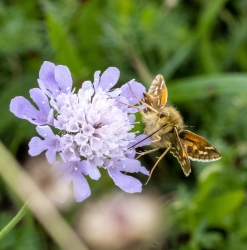 | 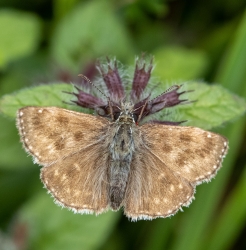 |  |
| Silver-spotted Skipper on Scabious Photo © Francis Plowman | Dingy Skipper with Trombidium breei parasite (right side of head) Photo © Francis Plowman | Adonis Blue male & small moth Photo © Francis Plowman |
Portsdown Hill, Paulsgrove. From 1330-1600 eleven species were recorded. The NW breeze had little effect on the slopes and the temperature at 19 deg C with plenty of sunshine certainly helped. Meadow Brown reign supreme with two mating pairs noted. In both cases the male had the parasite Trombidium breei with its bright red colour clearly discernible. No sign of Clouded Yellow but one very washed-out Painted Lady was photographed. Total: Small White (15); Meadow Brown (366); Holly Blue (17); Brown Argus (1); Large White (5); Common Blue (M)(7)(F)(1); Gatekeeper (4); Chalk Hill Blue (M)(43)(F)(18); Painted Lady (1); Speckled Wood (1); Adonis Blue (M)(1). [Posted by Francis Plowman]
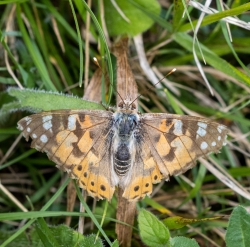 | 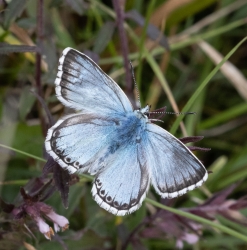 | 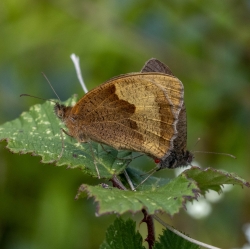 |
| Painted Lady Photo © Francis Plowman | Chalk Hill Blue male Photo © Francis Plowman | Meadow Brown female at left Photo © Francis Plowman |
Old Winchester Hill. Today I visited Old Winchester Hill arriving around midday and leaving at 3pm. The weather was overcast with little sunshine for the first hour then with sun temperatures reached 20 degrees. Many Meadow Browns were in flight almost all females, while a few fresh male Chalk Hill Blues flew with the females. A single fresh Silver-spotted Skipper was seen on the South side of the hill Fort, while a further 3 were recorded at the bottom of the car park slope. At this spot and along the path towards the wood a total of 15 male Adonis Blues made a colourful display with 3 females also recorded. Totals: Brimstone 4M 2F, Large White 4, Small White 41, Adonis Blue 15M 3F, Chalk Hill Blue 15M 11F, Common Blue 7M 3F, Holly Blue 1, Gatekeeper 7, Meadow Brown 388, Small Heath 44, Speckled Wood 8, Red Admiral 2, Silver-spotted Skipper 4. [Posted by Richard Symonds]
Noar Hill. This morning I visited Noar Hill in company with my father Roy Symonds. The temperature reached 19 degrees during a period of 2 hours and 15 minutes walking most of the site. A heavy shower occurred just as we walking from the site. Meadow Browns were flying everywhere and also there was a reasonable number of Small Heaths. Searching the site, we were looking for the Brown Hairstreak where in the large clearing near to the triangle a fresh female appeared which ovipoisted 4 eggs then fed on Ragwort blooms, watching and photographing her from 12.25 to 12.30 before she flew high into a tree. This was the first Brown Hairstreak I had seen since 2010 when I lived in Hampshire, a wonderful sight. Totals: Large White 3, Small White 3, Brown Hairstreak 1F, Common Blue 17M 10F, Holly Blue 3, Gatekeeper 5, Meadow Brown 97, Small Heath 30, Speckled Wood 10, Red Admiral 1. [Posted by Richard Symonds]
Butser Hill Field Trip. The ever increasing threat of rainfall as we all walked down to the bottom of Butser Hill was forever on our minds although we did see the sun, the wind was getting up and it was decidedly cool. The species count was quite low consequently but we did pick up two of our three target species. The Adonis Blue seems quite settled here now and there was at least twenty or more individuals seen, although I only saw males. We had to search high and low (literally) along very steep slopes to try and pin down a Silver-spotted Skipper. We did manage it with a lot of perseverance, and many of the group hadn’t seen one before, and it was really worth all the effort. We saw about three or four but I think this site is quite late, due to the fact the southern slope takes a while to see the sun. However after lunch we drew stumps as on the horizon the sky was black and we hot footed it back to the carpark. [Posted by Ashley Whitlock]
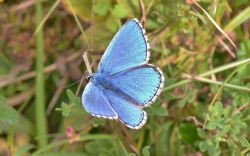 | 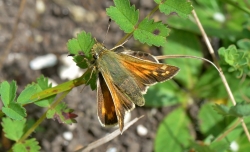 | 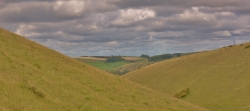 |
| The Adonis Blue is well settled on this site now Photo © Ashley Whitlock | Silver Spotted Skipper Photo © Ashley Whitlock | Ever increasing cloud made us draw stumps early Photo © Ashley Whitlock |
Stockbridge Down. Cool and breezy with occasional light rain showers this morning at Stockbridge Down. At least 200 Meadow Browns seen, disturbed as I walked through the grass. I also saw about 30 Small Heaths, mostly at roost, as were 1 Brimstone, 1 Small White and 4 Common Blues. Chalk Hill Blues are well past their best, but at least 50 seen, surprisingly active despite the inclement weather. [Posted by Adrian Hoskins]
Oxenborne Down. Photographs of Adonis Blue and Silver-spotted Skipper from Oxenborne Down on 25th August. [Posted by Richard Symonds]
 |  |
| Adonis Blue male. Photo © Richard Symonds | Silver Spotted Skipper. Photo © Richard Symonds |
Oxenborne Down. After visiting Chalton Down my father and I visited Oxenborne Down where despite frequent cloudy weather the temperature reached 18.5 degrees. Just as we walked into the site a very worn and damaged female Silver-washed Fritillary was seen. Many Chalk Hill Blues of both sexes and Meadow Browns were flying. We searched for Silver-spotted Skippers and started to find several in one area, all mostly in fresh condition. Suddenly I spotted a male Adonis Blue which briefly landed. Later during an overcast period I discovered 4 fresh male Adonis Blues all resting on the ground within a small area which enabled me to obtain several photographs. Totals: Large White 1, Adonis Blue 5M, Chalk Hill Blue 51M 30F, Common Blue 17F, Gatekeeper 17, Meadow Brown 61, Small Heath 4, Silver-washed Fritillary 1F, Silver-spotted Skipper 11. [Posted by Richard Symonds]
Chalton Down. Visited my old haunt at Chalton Down today having travelled from my home in Cornwall to visit my father Roy Symonds. In his company the sun was out and the temperature was 20.5 degrees. Numbers of Chalk Hill Blues at the site have decreased significantly following lack of grazing but over 70 of a mixture of both males and females in worn to fresh condition were recorded. I witnessed a female Meadow Brown caught in a spider Web which was quickly ceased by the colourful and large Wasp Spider. Totals: Brimstone 1M, Large White 2, Small White 2, Brown Argus 1, Chalk Hill Blue 51M 25F, Common Blue 3M 9F, Small Copper 1, Gatekeeper 1, Meadow Brown 33, Small Heath 6. [Posted by Richard Symonds]
Noar Hill. A complete contrast in the weather today complete cloud cover, with the ever threat of rain…and boy did it rain. But not before we had seen a beautiful Female Brown Hairstreak sat on a leaf of Hemp Agrimony just waiting for the sun to appear, just so lucky to be looking in the right place at the right time as she took off as we approached never to be seen again. Also seen were Common Blues and Brown Argus in-between the showers. Never be put off by the threat of rain! Obviously it was too cloudy and cool to see any flying from any males over the Lecking trees, but the amount of butterflies and moths were a treat despite the weather, and we went home happy.? [Posted by Ashley Whitlock]
Portsdown Hill Field Trip. A decent day with sunshine all the way and it was very warm for walking so we didn’t go too far and made our way to an area where I have always thought in the past that this would be a suitable area for the Adonis Blue. Over the last couple of seasons the species has been seen, but is it breeding? There is obviously their foodplant there as there is a lot of Chalk Hill Blues to be seen. Also the species has turned up in reasonable numbers at other sites in the Meon Valley as well, so it could well be spreading by natural means. It took a few minutes to tune into the area where there was a lot of other blues Chalk Hill Blues were very common and Common Blues were flying there as well. Then Bingo, a male Adonis Blue was spotted and he was in fine condition, probably a day or two old.
So that was one target species seen, along with several Autumn Ladies tresses, a very delicate Orchid seen on the short turf. We also saw a lovely Great Green Bush Cricket which posed rather nicely, and in the afternoon we espied several eggs laid by female Brown Hairstreak, but alas there wasn’t any luck seeing the female flying about or laying her eggs in the great swathes of Blackthorn on the northern slopes of Portsdown Hill, however several males were seen flying around a lecking tree close to the Churchillian car park. [Posted by Ashley Whitlock]
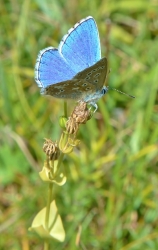 |  | 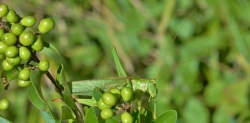 |
| Male Adonis Blue Photo © Ashley Whitlock | Mating Chalkhill Blues Photo © Ashley Whitlock | Great Green Bush Cricket Photo © Ashley Whitlock |
Clouded Yellow at Magdalen Hill Down. I was thrilled to see a couple of Adonis Blues on the chalk scrape at Magdalen on the rescheduled Butterfly Walk. Then we saw at least 6 on the eastern side of the Hillside, some more further across the Hillside and one in the Tumuli field. An afternoon walk had a Clouded Yellow appear on the scrape on the Extension field after a Dark Green Fritillary just whizzed by, a butterfly I've not seen at Magdalen before. Not to mention all the Chalk Hill Blues, Brown Argus or the Jersey Tiger moth on the side of the stone masons van. So a blissfully warm, sunny and beautiful day for butterflies at Magdalen Hill Down. [Posted by Fiona Scully]
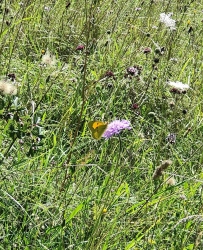 |
| Clouded Yellow Magdalen Hill Down Photo © Fiona Scully |
Long-tailed Blue in Fareham. Long-tailed Blue seen on everlasting pea in a garden at Hill Head, Fareham on the afternoon of 23/08/23. Egg-laying may have taken place as unidentified eggs were found the following morning.
Observers: Saphira Berwick and Margaret Pink
Photo: Saphira Berwick [Posted by Richard Levett]
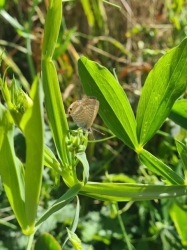 |
| Long-tailed blue, Hill Head Photo © Richard Levett |
Three Solent Areas - In Search of Yellow. Three sites bordering The Solent coast were visited. In all three Clouded Yellow has been observed often in previous years. Sadly, despite the glorious sunny weather (23 deg C) with mostly a pleasantly warm southerly breeze no Colias crocea was seen.
Haslar Sea-Wall Car Park Scrub, Gosport (1215-1255). Total: Holly Blue (3); Small White (3); Small Heath (6); Meadow Brown (4); Small Copper (1); Common Blue (M)(1); Brown Argus (1); Gatekeeper (1).
Gilkicker Point, Gosport (1300-1400). Total: Holly Blue (8); Small White (12); Common Blue (M)(3); Small Copper (1); Gatekeeper (1); Red Admiral (1).
Monks Hill Promenade & Seafield Park, Hill Head (1420-1515). Total: Holly Blue (6); Small White (14); Common Blue (M)(7); Brown Argus (2); Meadow Brown (6); Gatekeeper (4); Small Heath (6); Small Copper (1). [Posted by Francis Plowman]
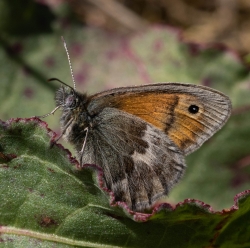 | 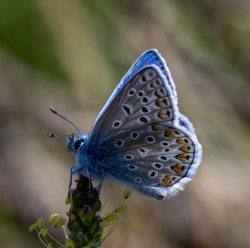 |  |
| Small Heath, Haslar site Photo © Francis Plowman | Common Blue male, Gilkicker Photo © Francis Plowman | Holly Blue, Seafield Park Photo © Francis Plowman |
Southampton Common veteran. A quick 40 mins. on the Common, early afternoon, gave a tally of Holly Blue (50+) - mainly grouped around the heather patches, and one battle-scarred Silver-washed Fritillary. Not much else of note (few Meadow Brown, Gatekeeper & Small White), though the Dragonflies & Damselflies are still present in reasonable numbers. [Posted by Jon Holden-Dye]
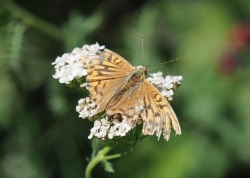 |
| Silver-washed Fritillary veteran Photo © Jon Holden-Dye |
Magdalen Hill Down, Winchester. Mostly a linear hill contour walk from the easternmost corner to the western gate from 1225-1500 realised sixteen butterfly species. The temperature was low twenties throughout with plenty of sunshine but a very intrusive SW wind that swept butterflies away often as the shutter was about to shut! One male Adonis Blue entertained us royally as the sun's rays bounced off its azure wings and flashed like neon. Stunning natural beauty. Total: Gatekeeper (23); Meadow Brown (158); Holly Blue (2); Brimstone (M)(6)(F)(3); Small Heath (34); Large White (1); Small White (13); Speckled Wood (1); Brown Argus (6); Common Blue (M)(16)(F)(2); Chalk Hill Blue (M)(53)(F)(11); Adonis Blue (M)(3); Green-veined White (1); Small Copper (1); Red Admiral (1); Peacock (1). [Posted by FRANCIS PLOWMAN]
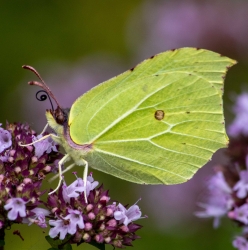 | 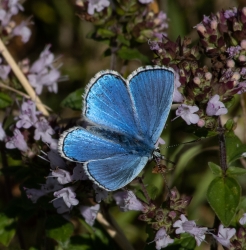 | 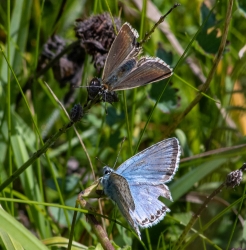 |
| Brimstone male Photo © FRANCIS PLOWMAN | Male Adonis Blue flashes its colours! Photo © FRANCIS PLOWMAN | Female & male Chalk Hill Blue in stand-off Photo © FRANCIS PLOWMAN |
Old Winchester Hill. I spent a couple of hours in warm sunshine this afternoon strolling up and down the "car park" slope at Old Winchester Hill. I counted about 15 Silver-spotted Skippers, mostly males in slightly worn condition, 8 very fresh male Adonis Blues, about 15 worn Common Blues, 50 Chalk Hill Blues in various states of wear, 3 very faded Small Coppers, 4 Brimstones, 15 Small Heaths, about 80 Meadow Browns including several fresh specimens, and about a dozen faded female Gatekeepers. [Posted by Adrian Hoskins]
Second-brood Peacock larvae at Great Fontley. A pleasure to find second-brood Peacock larvae on the Great Fontley nettles originally cultivated to attract second-brood Small Tortoiseshells, which never appeared. Ironically, an immaculate second brood Small Tort. was later seen on Verbena bonariensis in the 'Brown Hairstreak corner'. Also seen there enjoying the Verbena was a Small Copper. Elsewhere, Brimstones and Small Heath were noted. No other vanessids abroad, but a large brownish insect was seen flying to and fro through a glade at break-neck speed, never hesitating for a second to allow identification, assumed to be an Oak Eggar? [Posted by Andrew Brookes]
Moth trap in my garden at Leigh Park. I had my moth trap on overnight in my garden at Leigh Park from 21st Aug into the following morning. I caught 38 species some of the highlight included Jersey Tiger 3, Garden Tiger 2, Vestal, White Point 2, Least Yellow Underwing, Burnished Brass, Maidens Blush, Spectacle, Small Wainscot 2, Turnip Moth 2, Lesser Swallow Prominent, Rusty-dot Pearl 2, Silver Y 2, Setaceous Hebrew Character 10, the three most common species were Vine's Rustic 46, Pale Mottled Willow 24, and Bright-line Brown-eye 22. [Posted by Barry Collins]
Wall on Portsdown Hill. Wall was seen on Portsdown Hill about 3.00pm
Landed briefly about 8 feet away, good view through bins
South-west of Fort Southwick [Posted by James Clark]
Monks Walk, Frater Fields & Woods, Gosport. Since my last walk here 12 days ago the species' count has fallen two to 13. Having said that numbers are holding up well with both Speckled Wood and Small Copper noted in 'mint uncirculated' condition! Clouds largely predominated throughout the walk (4 hours from 1150) although the temperature was stable at 20 deg C. One of the fresh Small Copper showed a spattering of blue scales on its hindwings; sharing the butterfly meadow, one other also had a few blue scales but all the other six specimens were normal. Total: Green-veined White (F)(1); Small White (M)(15)(F)(10); Large White (4); Speckled Wood (20); Gatekeeper (9); Red Admiral (7); Holly Blue (25); Meadow Brown (21); Comma (6); Brown Argus (4); Small Copper (8); Common Blue (M)(6); Small Heath (3). [Posted by Francis Plowman]
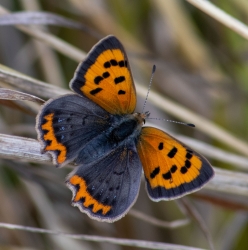 | 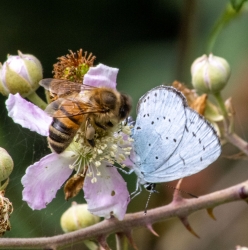 | 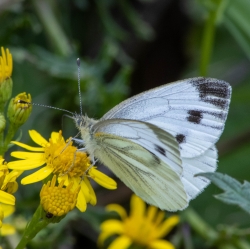 |
| Small Copper showing a few blue scales Photo © Francis Plowman | Holly Blue female & bee Photo © Francis Plowman | Green-veined White female Photo © Francis Plowman |
Portsdown Hill NNR. Second helping of visiting Portsdown Hill with Mark Tutton gleaning more information on where are the best areas are to look for the elusive Brown Hairstreak, and they are mostly in areas where I have long suspected where they would be over the years. We thought we saw a male over the top of an Ash Tree in one of the hedgerows on the border of Fort Widley, and the behaviour was certainly how I saw them at Noar Hill last week. But alas the weather, being mostly thick cloud, with very little sun to speak of, just about put paid to any possibility of seeing a female, going about her business.
We did find some eggs so they have been busy with egg-laying over the past few weeks. I did come across a yellow colouration Jersey Tiger Moth f. Lutescens which I don’t think I’ve ever seen before. Last week we saw over 21 species today we barely made 10 what a difference a week makes! [Posted by Ashley Whitlock]
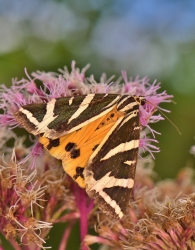 | 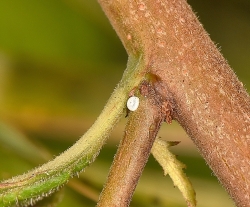 | 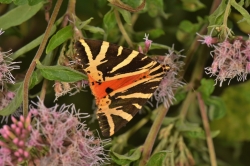 |
| f Lutescens Jersey Tiger Moth imbibing on Hemp Agrimony Photo © Ashley Whitlock | Brown Hairstreak egg Photo © Ashley Whitlock | Jersey Tiger Moth Photo © Ashley Whitlock |
Jersey Tiger Moth seen on Thursday 17th August. Jersey Tiger Moth seen in Brighstone, Isle of Wight [Posted by KATRINA THOMAS]
Jersey Tigers at North Baddesley.. Seen 18-8-23 a Jersey Tiger moth nectaring on buddleia at my reserve in North Baddesley, Then 5 in moth trap this morning. [Posted by kevin ross]
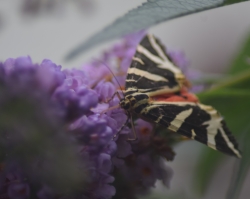 |
| Photo © kevin ross |
Browndown (North) Gosport. On a warm afternoon from 1330-1545 (23 degrees Celsius) we recorded thirteen species. It was tremendous to count at least 26 Grayling on the heath. The approx. 100 square metre heathland around the main path intersection where they are easily found has extended and we found the species in two further places some 400 metres further westwards. The common denominator was the availability of heather which is widespread and so brightly coloured this year. Some 26 days after last recording Small Skipper/Essex Skipper at this site, a rather stalwart Small Skipper was found in pretty good condition and still zipping around and feeding. Total: Holly Blue (23); Small White (6); Large White (5); Red Admiral (5); Speckled Wood (6); Meadow Brown (24); Brimstone (F)(2); Grayling (26); Small Heath (10); Gatekeeper (2); Common Blue (9); Brown Argus (10); Small Skipper (1). [Posted by FRANCIS PLOWMAN]
 | 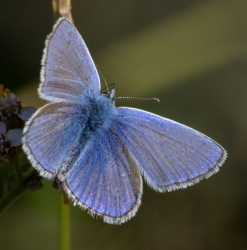 | 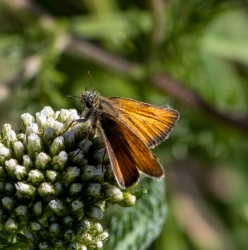 |
| Grayling Photo © FRANCIS PLOWMAN | Common Blue male Photo © FRANCIS PLOWMAN | Small Skipper Photo © FRANCIS PLOWMAN |
Browndown (South) Gosport. Eleven species coped with the easterly breeze and overcast skies on a wander in two parts from 1000-1215 and then returning to the car at Elmore, from 1300-1435. (18-23 deg C). The 'target' species of Grayling was our first butterfly of the morning after almost 50 minutes from entering the gate! Most of the six seen were showing clear signs of aging (as, indeed, is the recorder!) Purple Hairstreak was not found on the low oaks but then the sun wasn't shining and the wind cool and strengthening. It appears that Small Heath numbers are higher with the second emergence and Holly Blue numbers continue to surprise with many feeding avidly on the colourful heathers. Total: Grayling (6); Small White (18); Holly Blue (19); Brown Argus (15); Common Blue (15); Gatekeeper (9); Small Copper (4); Small Heath (24); Meadow Brown (25); Speckled Wood (3); Large White (4). [Posted by Francis Plowman]
 | 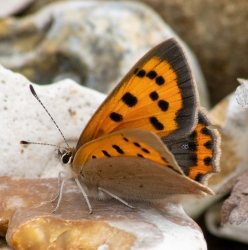 |  |
| Grayling Photo © Francis Plowman | Small Copper Photo © Francis Plowman | Female Brown Argus (top) rejects her male suitor Photo © Francis Plowman |
Browndown (South) Gosport. Additional photographs of today's walk. [Posted by Francis Plowman]
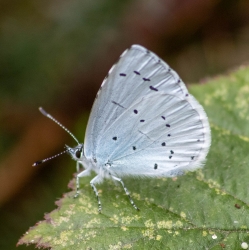 | 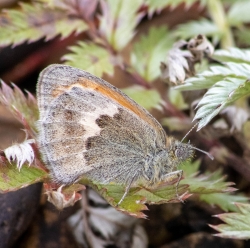 | 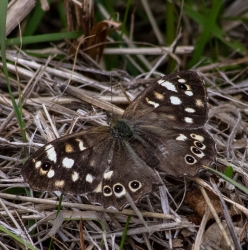 |
| Holly Blue female Photo © Francis Plowman | Small Heath Photo © Francis Plowman | Speckled Wood female Photo © Francis Plowman |
Brown Hairstreak at Titchfield Haven NNR. A sighting of a Brown Hairstreak was made at Titchfield Haven NNR recently, in the vicinity of the Knights Bank hide by an unnamed volunteer at the reserve and reported on Hampshire Butterflies Facebook group. [Posted by Andrew Brookes]
Portsdown Hill (East). Walking the slopes and tracks immediately in front of Fort Widley, I recorded the following, Brimstone 2M 2F, Small White 1, Holly Blue 2, Gatekeeper 2, Meadow Brown 1, Comma 1. [Posted by Roy Symonds]
Fort Widley, Portsdown Hill. Today I visited Fort Widley, Portsdown Hill where the temperature was 23 degrees. Being a regular visitor, I was intrigued by the recent Brown Hairstreak sighting reported here a few days ago. I searched several areas but with no luck. Totals: Brimstone 1M 1F, Small White 3, Gatekeeper 2, Meadow Brown 1, Speckled Wood 2. [Posted by Roy Symonds]
Moth trap on in my Garden at Leigh Park. We had our moth trap on overnight in our garden at Leigh Park from 15th Aug into the following morning. We caught 28 species some of the highlights included Poplar Hawk 2, Straw Underwing 2, White Point 3, Orange Swift, Swallow Prominent, Bordered Beauty, Garden Tiger, Lesser Broad-bordered Yellow Underwing 5, Vine's Rustic 20.
There was also a Humming-bird Hawk-moth nectaring on the buddleia in the back garden. [Posted by Barry and Margaret Collins]
Adonis blue on Portsdown hill. A male seen at 12:30 on the slope above the western end of the chalkpit. Also at least 30 Chalk Hill Blues on same area of slope which was short grass with only a few shrubs. Also in the same area a Privet Hawk moth caterpillar which was very noticeable feeding out in the open on a low bush of privet. [Posted by Keith Turner]
Portsdown Hill First. After watching England get a great win against Australia I thought I would take the dog for a walk on Portsdown. Following yesterday's success finding Brown Hairstreak with Ashley I visited a nearby area and bumped into Peter Gammage who had just seen a female which had since disappeared. I waited around for a while and before long I spotted a golden triangle creeping amongst the Blackthorn. I watched her for around twenty minutes as she flitted around the young suckers laying four or five eggs before she flew off over a hedge. I moved off to another area on the hill to see how the Chalk Hill Blues were doing and imagine my surprise when I spotted a pristine male Adonis Blue - a first for me on Portsdown Hill. Hopefully they might establish themselves and take advantage of the good habitat management. [Posted by Mark Tutton]
 | 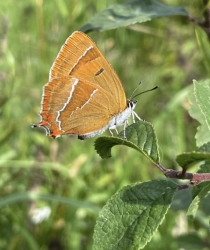 | 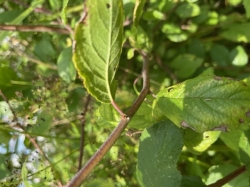 |
| Adonis Blue - a first! Photo © Mark Tutton | Nice pose Photo © Mark Tutton | Freshly laid Photo © Mark Tutton |
Noar Hill Field Trip. Noar Hill Field Trip 16th August 2023
Very warm weather greeted us at a site which is full of wild flowers you don’t know where to look and looking for the elusive Brown Hairstreak is not an easy task. I had mentioned one of the ‘lecking trees’ in my brief and low and behold we got there and there was several Male Brown Hairstreaks having a chase and a battle intermingling with several Purple Hairstreaks as well. The Brown Hairstreaks were on an Oak so it was hardly surprising that they were being chased off as trespassers!
Close by there was an area full of Hemp Agrimony and from past experience there is normally a male or female imbibing on this and sure enough there was a male having a good old feast. Unfortunately we didn’t see a female Brown Hairstreak as this site tends to be quite late compared with Shipton Bellinger. There were lots of other invertebrates flying around, good numbers of Common Blue with small numbers of Brown Argus, and Small Copper. We also saw one of the last Small Blues in one of the pits. Many thanks to everyone for an excellent field Trip.
Do not forget that next Wednesday’s Field Trip is now at Portsdown hill, not Charlton Down as advertised starting at 10:30am, bring lunch please.? [Posted by Ashley Whitlock]
 | 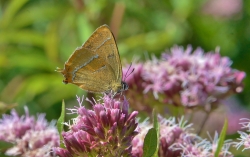 | 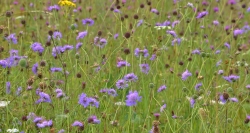 |
| Male Brown Hairstreak on Hemp Agrimony Photo © Ashley Whitlock | Male Brown Hairstreak on Hemp Agrimony Photo © Ashley Whitlock | Meadow full of wild flowers mainly Field Scabious Photo © Ashley Whitlock |
Chalton Down. After a visit to Oxenbourne Down, I visited nearby Chalton Down. Here the numbers of Chalk Hill Blues did not even reach half a century. Browns and a single Common Blue the other main families in flight. Totals: Brimstone 3M 2F, Small White 2, Chalk Hill Blue 38M, Gatekeeper 8, Marbled White 2, Meadow Brown 4, Small Heath 1, Comma 1. [Posted by Roy Symonds]
Oxenbourne Down. Today I visited Oxenbourne Down where the temperature was 20 degrees. Here I was looking for the Silver-spotted Skipper and was successful in recording a single male. Male Chalk Hill Blues were flying everywhere, although numbers are lower than usual. Other highlights were a single Brown Argus and a single Small Blue. Totals: Brimstone 2M 2F, Small White 1, Brown Argus 1, Chalk Hill Blue 120M, Small Blue 1, Gatekeeper 21, Meadow Brown 14, Ringlet 2, Small Heath 3, Silver-spotted Skipper 1. [Posted by Roy Symonds]
Stockbridge Down. Today I spent about 2 hours in the warm midday sun at Stockbridge Down. Chalk Hill Blues are still fairly numerous - about 250 seen, many of which are in quite fresh condition. Other species included 3 Brown Argus, 20 worn Common Blues, 400 Meadow Browns, 20 fresh Small Heaths, 10 worn female Gatekeepers, 50 Small Whites, 2 Large Whites and 35 Brimstones. Despite covering most of the site, I didn't see a single Red Admiral or Peacock, both of which were in high numbers a couple of weeks ago. [Posted by Adrian Hoskins]
Old Winchester Hill, Nr Warnford. Seventeen species booked today on a walk from 1020-1330 (17-23 deg C) mostly in warm sunshine and light SW breeze. We took the top path towards and around the hill fort before descending and walking the narrow valley path before turning right and once again using the furthest top path back to the car park. We did not attempt the car park slope to the valley floor discretion winning over valour! But probably that's why we didn't see either Adonis Blue nor Silver-spotted Skipper where previously we have seen both. Nevertheless, it was a terrific wander with plenty to see as well as hundreds of butterflies; eg, gorgeous natural floral displays, a Common Lizard with a grass hopper in its jaws, a grounded Buzzard being harassed noisily by two Crows and the distant view to The Solent and Isle of Wight beyond was simply stunning. Total: Small White (55); Speckled Wood (5); Meadow Brown (259); Gatekeeper (170); Red Admiral (19); Common Blue (F)(7)(M)(50); Brimstone (F)(20)(M)(51); Peacock (12); Small Heath (3); Brown Argus (6); Holly Blue (16); Large White (9); Small Copper (2); Green-veined White (F)(4)(M)(4); Chalk Hill Blue (F)(3)(M)(26); Painted Lady (1); Comma (1). [Posted by Francis Plowman]
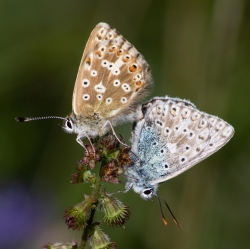 | 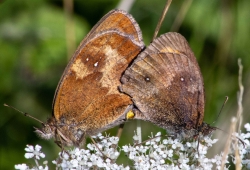 | 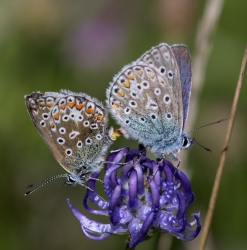 |
| Chalk Hill Blue female at left Photo © Francis Plowman | Gatekeeper female at left Photo © Francis Plowman | Common Blue female at left Photo © Francis Plowman |
Old Winchester Hill, Nr Warnford. Extra photographs. [Posted by Francis Plowman]
 |  | 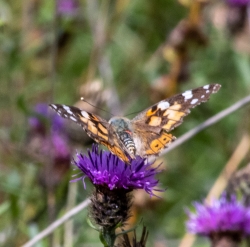 |
| Small Copper & companion! Photo © Francis Plowman | Meadow Brown male Photo © Francis Plowman | Flighty Painted Lady Photo © Francis Plowman |
Portsdown Hill. I visited this site with Mark Tutton, on a very warm day, more like summer and he and I were searching for the illusive Brown Hairstreak. Over the last decade or so the species has had a tentative foothold on the area. The area is covered in Blackthorn thickets, in fact every hedgerow is Blackthorn, and there are suckers always growing in the meadows which are to their liking to lay their eggs on. We had been searching for about 30 minutes when something caught my eye and there she was a beautiful female Brown Hairstreak just landed in front of us typically well above our heads, but close enough to see the patterning on her wings. She stayed with us for a couple of minutes and then she flew off I suspect to start egg laying, although I lost sight of her.
We only saw the one in a couple of hours of searching. We also had good views of Oak Eggar Moths which fly around like crazy, being very hard to follow. Also a male Dark Green Fritillary made a pass as well which was a surprise. Other species of note were Chalk Hill Blue, Small Copper, Brown Argus, formidable counts of Holly Blue, as Mark said’ one seen at every footfall!’ Also several lovely Jersey Tiger Moths were observed as well which seem to be having a bumper year as well as the Holly Blue , and Red Admiral.? [Posted by Ashley Whitlock]
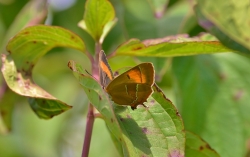 | 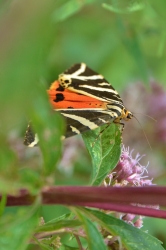 | 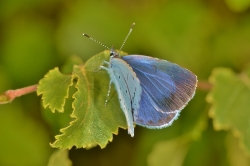 |
| Female Brown Hairstreak on Portsdown Hill Photo © Ashley Whitlock | Jersey Tiger Moth Photo © Ashley Whitlock | Holly Blues were extremely common Photo © Ashley Whitlock |
Kevin R's reserve - North Baddesley. My last trip to Kevin's reserve was back in April. This morning's visit was warmer with some sun but still not perfect butterfly weather. But never mind as a visit to Kevin's always includes a search for reptiles..
Whilst there weren't that many butterflies on the wing the following species were seen: Brimstone, Red Admiral, Peacock, Holly Blue, Silver-washed Fritillary (m), Gatekeeper and Ringlet. There was also a Marsh Fritillary web with a least 4 caterpillars wriggling in the sun (probably about 6-8 mm so would guess 2nd or 3rd instar?). There was also what I believe to be a Copper Underwing moth sheltering in one of the outbuildings.
On the reptile front we were lucky to see several adders and grass snakes, plenty of Slow Worms and a few small lizards. [Posted by Nic Burns]
 | 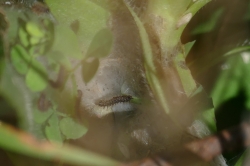 |  |
| Ringlet Photo © Nic Burns | Marsh Fritillary web Photo © Nic Burns | Copper Underwing (?) Photo © Nic Burns |
Brown Hairstreak at Titchfield Haven NR. Hampshire Butterflies Facebook reports the sighting of a Brown Hairstreak at Titchfield Haven, near the Knight's Bank Hide, by an unnamed volunteer on 9 August. The accompanying photo in that report shows a BH nectaring on Hemp Agrimony, though whether this is the actual insect is unclear. [Posted by Andrew Brookes]
The tiger who came to tea. Sitting on my garden bench having a brew after some light pruning on Friday, I was pleased to see this Jersey tiger moth. It did a lap of the back garden and then settled on the fence beside me. [Posted by Kevin Freeborn]
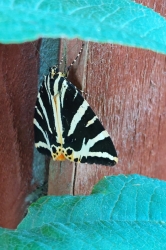 |
| Photo © Kevin Freeborn |
Shipton Bellinger & Broughton Down. Joined the branch field trip to Shipton Bellinger and bagged my penultimate species off the Hants & IOW list (Brown Hairstreak). The Oak Eggar (see Ashley's notes below) was another first for me and to cap the trip off there were a couple of surprise sightings - a Dingy Skipper and a Chalk Hill Blue.
Off to Broughton Down, on a sunny but very breezy afternoon, hoping to see a Silver-spotted Skipper to complete "The List" for first time. I did catch a brief glimpse of one as I climbed towards the Tumuli from the lower path.
There were still lots of Brown Argus and female Common Blues around and I counted at least 12 Dark Green Fritillary. I also came across a very perculiar beast which I have since ID'd as a Hornet Robberfly. Continuing my search across the dyke and then down to the southern point of the narrow triangular area I eventually found a second Silver-spotted Skipper which was happy to be photographed while clinging on and nectaring in the breeze. [Posted by Nic Burns]
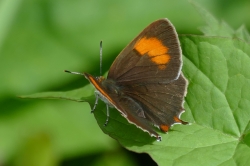 | 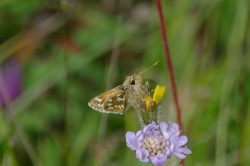 |  |
| Female Brown Hairstreak Photo © Nic Burns | Silver-spotted Skipper Photo © Nic Burns | Hornet Robberfly Photo © Nic Burns |
Shipton Bellinger Field Trip (part two). More photographs of the day.................. [Posted by Ashley Whitlock]
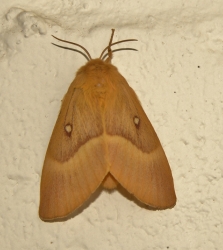 | 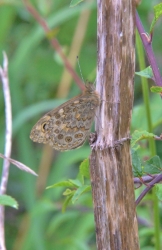 | 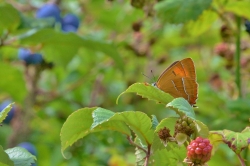 |
| Oak Eggar Moth Photo © Ashley Whitlock | Wall Brown camouflaged in the shrubbery Photo © Ashley Whitlock | Female Brown Hairstreak peek-a-boo.... Photo © Ashley Whitlock |
Shipton Bellinger Field Trip. When I looked out of my bedroom window this morning it had been raining and my initial thoughts were of a cool, wet windy and cloudy day with very little to see. That couldn’t have been further from the truth. An excellent turnout greeted me, and before we really got underway we had rescued an Oak Egger Moth which was trapped in the Village Hall, and I put it amongst some shrubbery as we set off. Even with the threat of rain on the horizon the sun did poke it head out on several occasions, which gave us glimpses of battling male Brown Hairstreaks in the main ride, these could be observed at close quarters, and several landed on a leaf and I could see they were looking quite battle scarred!
Several worn and fresh looking Wall Browns were also observed in the morning’s walk, along with Brown Argus, and Common Blue with Holly Blues skipping through the large areas of Ivy clinging from the tall shrubbery of Blackthorn. The Red Admiral was noted as being a lot scarcer today, being the butterfly of the year I suspect. Wall Browns became quite common dare I say it skipping along the hedgerows, and they did stop on several occasions to feed, but it was very brief. In the afternoon the sun did appear again on occasions, and we all had good observations of fresh Female Brown Hairstreaks well down on the ride and these were tasting the Blackthorn leaves with their feet and rubbing their abdomens up and down the stems of the blackthorn. In the end we counted up to 25 males and females which is a very good tally. Sadly for the second year running no Magpie Moths were observed, which is quite concerning, although we did see several Jersey Tiger Moths.
I’d like to thank all who came and made this a most enjoyable field trip. [Posted by Ashley Whitlock]
 | 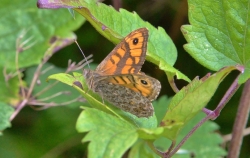 | 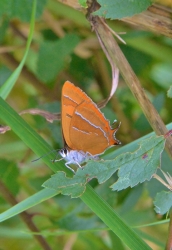 |
| Female Brown Hairstreak at rest Photo © Ashley Whitlock | Male Wall Brown at rest Photo © Ashley Whitlock | Female Brown Hairstreak Photo © Ashley Whitlock |
Haslar Sea Wall Car Park Scrub - Gosport. From ten o'clock until rain stop play at 10:40 just six species braved the overcast conditions and strong wind from the SW. Most butterflies were hunkered down low. The temperature soon dropped from 20 to 18.5 deg C when then the threatened rain fell heavily. Total: Meadow Brown (4); Gatekeeper (2); Common Blue (M)(3); Peacock (1); Speckled Wood (F)(1); Small White (3). [Posted by Francis Plowman]
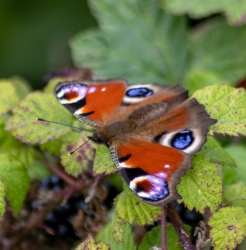 | 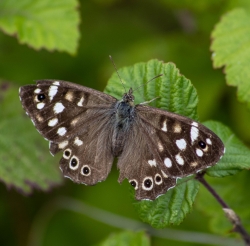 | 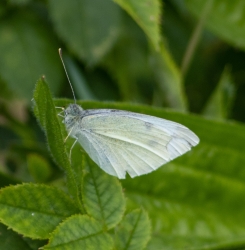 |
| Peacock Photo © Francis Plowman | Female Speckled Wood Photo © Francis Plowman | Small White Photo © Francis Plowman |
Seafield Park, Nr Hill Head. From 1105 to noon I managed to find just seven species across a windswept and overcast area just inland from The Solent (18.5 deg C, cloudy and very windy). I had hoped to check-out Monks Hill promenade for Clouded Yellow but the wind was far too strong. Nothing unusual to record although I was intrigued to watch a helpless worker bee caught in the grip of a large spider - possibly Wasp Spider? Total: Meadow Brown (11); Small White (2); Gatekeeper (8); Common Blue (M)(2); Red Admiral (2); Comma (1); Speckled Wood (F)(1). [Posted by Francis Plowman]
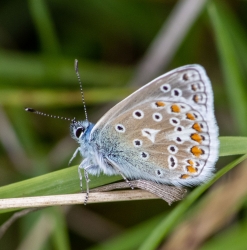 |  | 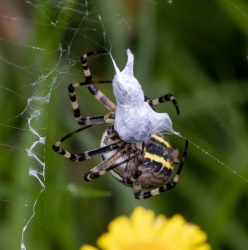 |
| Common Blue male Photo © Francis Plowman | Comma Photo © Francis Plowman | Wasp Spider & victim Photo © Francis Plowman |
Noar Hill. Visited Noar Hill today to search for the Brown Hairstreak. I was unsuccessful but still was able to record 11 different species. Totals: Brimstone 5M 5F, Large White 4, Small White 9, Green-veined White 1, Holly Blue 3, Gatekeeper 14, Meadow Brown 11, Ringlet 1, Small Heath 1, Peacock 1, Red Admiral 1. [Posted by Roy Symonds]
Chilling Coastal Area to Brownwich Cliffs, Nr Titchfield. After two days of better Summer weather I wanted to check-out the cliff-tops and shoreline for Clouded Yellow, walking from the wooded car park at Chilling and then out around the fields to the coast. Having investigated the shore westwards for 250 metres or so, we turn about and walk along the cliff top westwards towards Solent Breezes caravan park before turning inland and then eastwards back to the car park. From 1100-1400 the temperature went from 20 deg C to 24C and eventually we were under full sun. Sadly no Clouded Yellow but one Painted Lady whizzed past on a mission to chase a Red Admiral! Once again the cliff-top field has been planted generously with brassica mixed with wild flowers and the whites were very prominent here. The surprise was seeing a mobile Silver-washed Fritillary flying along the verges on Chilling Woods which is inaccessible currently. Total: Gatekeeper (25); Brown Argus (1); Speckled Wood (F4)(28); Common Blue (M)(1); Holly Blue (34); Painted Lady (1); Small White (74); Large White (22); Meadow Brown (26); Red Admiral (10); Small Copper (1); Brimstone (M)(3)(F)(1); Green-veined White (M)(1); Comma (4); Silver-washed Fritillary (1). [Posted by FRANCIS PLOWMAN]
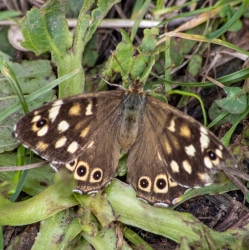 | 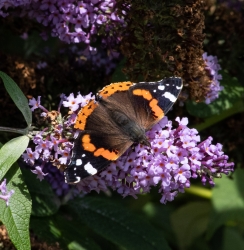 | 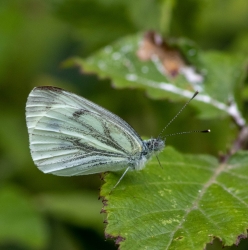 |
| Speckled Wood female Photo © FRANCIS PLOWMAN | Red Admiral female Photo © FRANCIS PLOWMAN | Green-veined White invalid male? Photo © FRANCIS PLOWMAN |
Moth trap in my garden at Leigh Park. We caught 27 species some of the highlights were Jersey Tiger, White Point 3, Rosy Rustic, Sallow Kitten, Maidens Blush, Dark Sword-grass, Mother of Pearl 12, Vine's Rustic 15 etc. [Posted by Barry and Margaret Collins]
Oxenbourne Down. We arrived at 1300 to a very cloudy sky with just a few Chalk Hill Blues flying around. Then at 1320 the sun came out to our relief, and what a difference that made butterflies galore.
Silver-spotted Skipper 6, Dark Green Fritillary 2 very worn individuals, Chalk Hill Blue 80, Brimstone 10, Small Copper 2, Brown Argus 4, other species seen but not counted Common Blue, Holly Blue, Red Admiral, Gatekeeper and Meadow Brown etc. [Posted by Barry and Margaret Collins]
Oxenbourne Down. Visited Oxenbourne Down today where the temperature was 20 degrees. Here the numbers of Chalk Hill Blues had almost trebled since my last visit, including the first females. Totals: Brimstone 1M, Large White 1, Small White 1, Chalk Hill Blue 81M 2F, Gatekeeper 2, Meadow Brown 24, Small Heath 4, Silver-washed Fritillary 1. [Posted by Roy Symonds]
Monks Walk, Frater Fields & Woods, Gosport. Species' numbers holding up still with 15 (again) recorded today including first second generation Small Heath. Purple Hairstreak photographed today at the southern and northern sectors although both specimens were showing signs of their age. Holly Blue numbers are soaring this year a trend which appears to follow across Hampshire. But it does look as if the skipper season has finally closed here. Total: Small White (23); Holly Blue (35); Large White (7); Meadow Brown (30); Comma (7); Gatekeeper (45); Brown Argus (5); Common Blue (M)(6); Peacock (1); Green-veined White (3); Brimstone (M)(2)(F)(1); Speckled Wood (19); Red Admiral (19); Purple Hairstreak (2); Small Heath (1). [Posted by Francis Plowman]
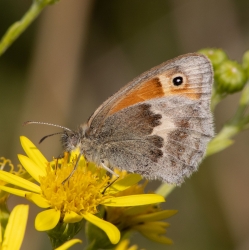 | 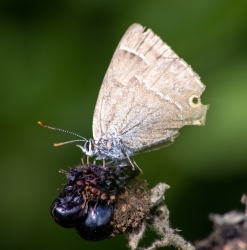 | 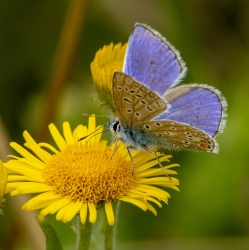 |
| Small Heath Photo © Francis Plowman | Faded Purple Hairstreak on Blackberry Photo © Francis Plowman | Common Blue male on Fleabane Photo © Francis Plowman |
Fort Purbrook, Portsdown Hill. Visited Fort Purbrook today where the temperature was 21 degrees. Not visited this site before but came to search for the Brown Hairstreak which James Clark had reported here on 30th July. After walking a little way I met James himself who was able to take me to the area where he had made his sighting. Unfortunately today was not successful with only a few butterflies on the wing. Totals: Common Blue 1M, Meadow Brown 2, Speckled Wood 3, Red Admiral 1. [Posted by Roy Symonds]
Havant Thicket. Today I visited Havant Thicket where the temperature reached 20 degrees. Plenty of Gatekeepers flying. Totals: Brimstone 1M 3F, Green-veined White 1, Small White 1, Gatekeeper 24, Meadow Brown 15, Ringlet 4. [Posted by Roy Symonds]
Tiger at Great Fontley. First insect seen on the buddleja at Great Fontley lunchtime today was a Jersey Tiger. Meanwhile on the hallowed south wall of the farmhouse, two Red Underwings slept beneath a windowsill 10 feet above us. With no means of safely rousing them, their underwings were presumed red, given their impressive overall size. Later, in the elm plantation, the first second-brood Small Heath of the summer was seen. [Posted by Andrew Brookes]
Noar Hill. Warm sunny weather and plenty of butterflies at Noar Hill this morning - circa 60 fresh Red Admirals, 40 Peacocks, 4 worn Commas, 1 Silver-washed Fritillary, 100+ Gatekeepers, 60+ weather-beaten Meadow Browns, 2 Small Heaths, 1 Speckled Wood, 5 Holly Blues, 3 Common Blues, 1 faded male Brown Hairstreak, 1 very faded Purple Hairstreak, 1 Small Copper, 1 Green-veined White, 30+ Small Whites, 15 fresh Brimstones. [Posted by Adrian Hoskins]
Fort Widley, Portsdown Hill. An hour's wander around Fort Widley's outer borders from 11 am recorded 13 species and my first Brown Hairstreak of the year. This was found along the main path about 50 metres from the small access gate. It was very low down and at one time far too close to photograph! The sunshine was warm (19.5 deg C) and very little breeze to interfere with a very good turn-out of butterflies. The flora in the area remains vibrant and extensive. Total: Meadow Brown (38); Brown Argus (6); Holly Blue (22); Small White (11); Large White (4); Gatekeeper (21); Speckled Wood (1); Brimstone (M)(2)(F)(3); Brown Hairstreak (1); Common Blue (M)(3)(F)(3); Small Blue (3); Red Admiral (1); Peacock (3). [Posted by Francis Plowman]
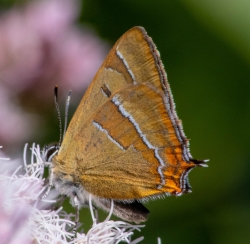 |  | 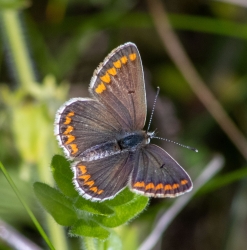 |
| Brown Hairstreak Photo © Francis Plowman | Common Blue female Photo © Francis Plowman | Brown Argus Photo © Francis Plowman |
Portsdown Hill, Paulsgrove. From noon until 2pm some 15 species were found on an east to west walk on the upper paths and fields. It was still warm around 20 deg C although the breeze was strengthening and clouds eventually built-up. Three mating pairs were recorded and photographs included as an additional report. Total: Meadow Brown (113); Gatekeeper (20); Large White (1); Small Blue (5); Comma (1); Chalk Hill Blue (M)(18); Green-veined White (1); Small White (23); Brown Argus (10); Holly Blue (43); Speckled Wood (12); Brimstone (M)(4)(F)(8); Common Blue (M)(9)(F)(1); Red Admiral (16); Peacock (16). [Posted by Francis Plowman]
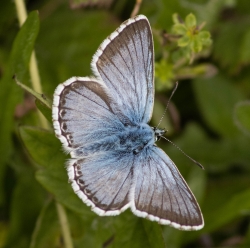 |  | 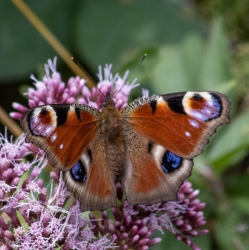 |
| Chalk Hill Blue male Photo © Francis Plowman | Small Blue Photo © Francis Plowman | Peacock Photo © Francis Plowman |
Portsdown Hill, Paulsgrove - Additional Photographs. Some extra photos from today's Portsdown Hill walk. [Posted by Francis Plowman]
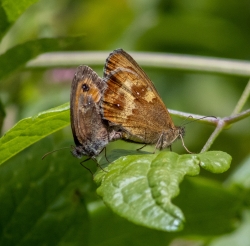 | 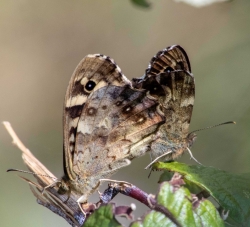 |  |
| Gatekeeper female right Photo © Francis Plowman | Speckled Wood female left Photo © Francis Plowman | Meadow Brown female top Photo © Francis Plowman |
Unusual garden butterflies in Hiltingbury. This afternoon, I was lucky enough to spot a Silver-washed Fritillary in our garden. This was the 23rd species for our garden this year, but more than this, it was the beautiful Valezina form of the female. Most years we have one or two Silver-washed Fritillaries visit our garden, but this is the first time we've had a Valezina. She gave us excellent views whilst nectaring on Marjoram.
The second butterfly of note was a rather strange looking female Gatekeeper. Clearly something had gone slightly wrong during emergence from the pupa, as both forewings had a fold along the back edge. In addition, rather than have a band of orange on the hindwing, there was simply a large, roughly circular, orange patch on each wing. Even so, the butterfly was happily nectaring on our Marjoram, and had no problems when flying. [Posted by Andy Barker]
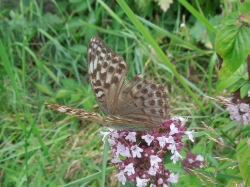 | 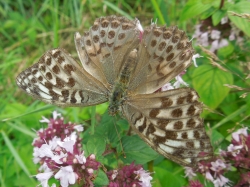 | 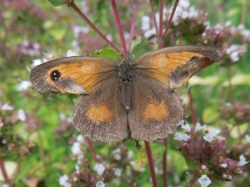 |
| Silver-washed Fritillary (var.Valezina) Photo © Andy Barker | Silver-washed Fritillary (var.Valezina) Photo © Andy Barker | Gatekeeper female (ab.) Photo © Andy Barker |
Adonis Blue on Portsdown Hill. Adonis Blue seen on Portsdown Hill today 6.8.23. Around a dozen Chalk Hill Blues in a favoured spot. Numbers of Red Admirals and Peacocks much reduced on last week. [Posted by James Clark]
 |
| Adonis Blue Photo © James Clark |
Long-tailed Blue in Havant. At 9:15 this morning in my Havant garden l had good views of a relatively fresh male Long-tailed Blue which I got some adequate photos of. I have large amounts of wild sweet peas in my garden. It was present for about 15 minutes and has failed to put in any further appearances.It was harassed by a Small Copper, a butterfly I rarely have in my garden. [Posted by Alan wingrove]
Members Day Magdalen Hill Down Reserve. A huge Thank you to members who joined us at St Swithun’s for Members Day, it is always a pleasure to be able to gather and share time with you! Thanks to all our speakers and despite the rain our walk on Magdalen Hill Down was rewarded with sightings of Chalk Hill Blues, Adonis Blues, Brown Argus and my first Small Heath of the year! It’s the last day of this year’s Big Butterfly Count - Do enjoy taking part! More on members day in the October newsletter. [Posted by Suzie Brown]
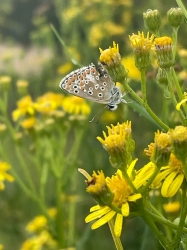 | 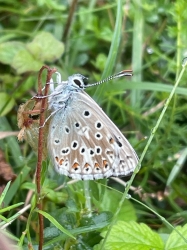 | 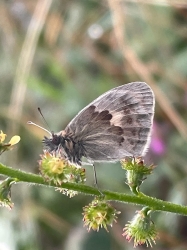 |
| Brown Argus Photo © Suzie Brown | Chalk Hill Blue Photo © Suzie Brown | Small Heath Photo © Suzie Brown |
Browndown (North) Gosport. There appeared to be a short window in Storm Antonio this afternoon.........just forty minutes to be exact from 1420 (19.5 deg C). I wanted to see if Grayling was still going strong on the heath so went directly there finding five 'hardy' species along the way. Seven Grayling were soon 'put up' before a hasty photograph as heavy rain returned, as did I to home, arriving somewhat damper than I left! Total: Small White (1); Large White (1); Gatekeeper (4); Comma (1); Speckled Wood (F)(1); Grayling (7). [Posted by FRANCIS PLOWMAN]
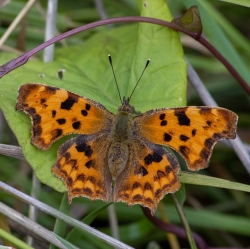 |  | 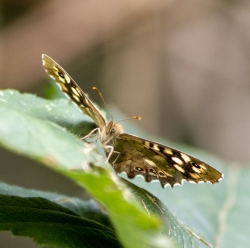 |
| Comma Photo © FRANCIS PLOWMAN | Grayling Photo © FRANCIS PLOWMAN | Speckled Wood female Photo © FRANCIS PLOWMAN |
Silver-washed Fritillary in Sheet. On 29th July 2023 two Silver-washed Fritillary were seen on our allotment buddleia plants. The allotment site is in Sheet, near Petersfield (Hampshire), next to a rough meadow field which borders mixed woodland. We saw one again on Tuesday 1st August. We were absolutely certain they were silver-washed as we had the sun catch the underwing and saw the stripe patterning very clearly. We did not have a camera at the time but we are hoping they will return and we will send photo in due course. [Posted by Patricia Helen Wooldridge]
Yew Hill Reserve Walk. Despite the heavy cloud and cool temperature there was a good turnout for the branch's second Yew Hill reserve walk of the season and the Chalk Hill Blues, the main target species, did not disappoint, flying up in good numbers and posing for the photographers.
Other species noted were Small White, Large White, Brown Argus, Common Blue, Red Admiral, Comma, Peacock, Gatekeeper, Meadow Brown and Speckled Wood along with a number of day flying moths. [Posted by Rupert Broadway]
 | 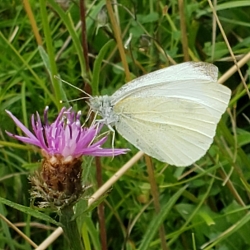 |
| Chalk Hill Blue at Yew Hill Photo © Rupert Broadway | Large White at Yew Hill Photo © Rupert Broadway |
Monks Walk, Frater Fields & Woods, Gosport. Both the butterflies and the writer took advantage of another errant local weather forecast and enjoyed over four hours recording 15 species and some very high numbers at that. The temperature ranged from 19 deg C at 1015 to a balmy 22 degrees at 1440. A couple of hours later and the rain returned! A Jersey Tiger moth was on the wing and a Humming-bird Hawk Moth was on the buddleia in the butterfly meadow. Total: Large White (8); Gatekeeper (88); Speckled Wood (M)(40)(F)(4); Small White (19); Red Admiral (30); Comma (19); Green-veined White (7); Holly Blue (28); Common Blue (M)(7); Brown Argus (8); Meadow Brown (50); Peacock (3); Small Copper (5); Purple Hairstreak (1); Essex Skipper (1). [Posted by Francis Plowman]
 | 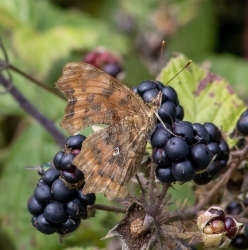 | 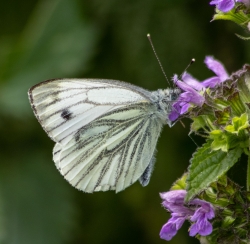 |
| Holly Blue male Photo © Francis Plowman | Comma enjoying a feast of blackberries Photo © Francis Plowman | Green-veined White male Photo © Francis Plowman |
Monks Walk, Frater Fields & Woods, Gosport. Extra shots from today's walk. [Posted by Francis Plowman]
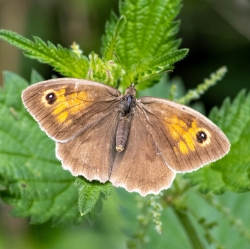 | 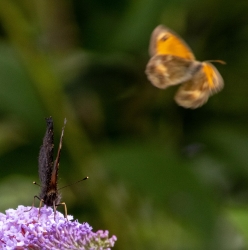 | 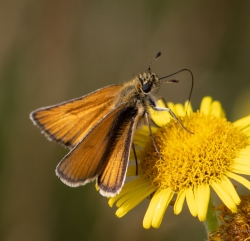 |
| Female Meadow Brown Photo © Francis Plowman | Peacock feeds Gatekeeper flies Photo © Francis Plowman | Essex Skipper Photo © Francis Plowman |
Brown Hairstreak on Portsdown Hill. I popped backed to Portsdown Hill to see if I could relocate the Brown Hairstreak that photobombed me earlier in the week and sure enough he was being very loyal to the same patch of Hemp Agrimony. It took me a while to locate him as there were half a dozen Red Admirals again who were joined by a couple of Comma and at least eight Holly Blue, a real hive of activity that was pleasing to see. Couldn’t locate any others but I’ll return when the weather picks up. [Posted by Mark Tutton]
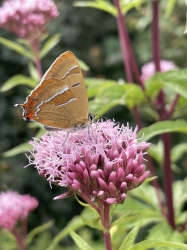 |
| Not so elusive this time Photo © Mark Tutton |
Grid Ref: SZ588826. Probable sighting of a Short-tailed Blue.
I'm from Bedfordshire and was on holiday last week in Shanklin. On Tuesday last week at about 4.00pm I came across a small blue butterfly at the bottom of the cliff along the promenade between Shanklin and Sandown, not far from the steps that lead up to the Blueberry Café. In flight form size and grey/blue colouring I thought it could be either a Small Blue or Brown Argus. When the butterfly actually settled on a large area of bracken about 3 metres back of the main path and the markings were similar to a small blue except on the rear hind wing it had two orange spots/markings similar to a purple hairstreak so I was confused to exactly what butterfly this was? I am a little behind with the times with not being able to get internet on my phone, but now looking at pictures on my computer I believe this was probably a Short-tailed Blue. I know this would be an extremely rare sighting, but it might be worth mentioning this to butterfly enthusiasts to keep an eye out who live locally in this area. Sorry I didn't report this earlier or was not able to get a photo, if still about hopefully someone else will. [Posted by David Tiffin]
Undercover Brown Hairstreak on Portsdown. Took the dog for a walk along Portsdown and took the opportunity to see if I could locate any Brown Hairstreak in what was decidedly non August weather. A few butterflies obliged as I carefully checked flowering Bramble, including a few Gatekeeper, which made me do a double take as always, but I didn’t see any Hairstreaks, or so I thought? There were plenty of Red Admiral, THE butterfly of the summer, and I stopped to take a photo of a large group on some Hemp Agrimony which was attracting all-sorts. However on checking the photo this morning, before deleting, I spotted a brown blob. Sure enough it was a male BH lurking in plain sight! [Posted by Mark Tutton]
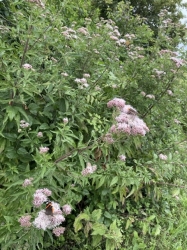 |
| Hiding in plain sight! Photo © Mark Tutton |
BC Youth Rangers at Magdalen Hill Down. A wonderful first day for the Youth Rangers pilot at Magdalen Hill Down Reserve with South Downs Landscape Officer Fiona Scully, Megan Lowe BC Engagement Officer and nine young people aged 13 -17. Kate Barret Head of Volunteering was also able to join us to set up camp and for our introduction. Youth Rangers were given an introduction to the chief concerns of rangers, the Reserve, Conservation aims and areas of application the charity give to employing conservation awareness, research and fulfilment. The strength of its volunteer capacity before we enjoyed some mallet activity posting out the fact filled Summer Butterfly and Moth Trail. Brown Argus and Chalk Hill Blues were spotted, Yellow Shell Moths, Holly Blues, Brimstones, Meadow Browns, Peacocks and Red Admirals amongst Longhorn Beetles, Bees, ants and the various species of flora on different parts of the site. The Youth Rangers helped to begin pulling clematis and some bramble that was overhanging a footpath and held a Butterfly Count practicing their ID skills. There was also chatter about how some are approaching their D of E award that starts in Year 9 at some schools and what subjects they are taking for GCSE so it is also a time spent of social value. We met branch treasurer Graham Nicol who was catching the sunshine to complete a transect route on the reserve. I was really pleased to volunteer and meet them. [Posted by Suzie Brown]
Stockbridge Down. The forecast rain arrived around 4pm by which time we had recorded 17 species on a pleasant wander that began at 13:15. The temperature then was 20 deg C with intermittent sunshine and SW breeze. By following the path eastwards to the smaller car park area (ie parallel to the main road) and then turning north-westwards we remained largely sheltered. We returned on a generally reciprocal course but following offset pathways from the outbound leg. Giving the windswept hilltop a miss we probably covered less than half of the area. Nonetheless, the place was simply alive with butterflies making the most of the precious warmth and spectacular flora. Total: Peacock (31); Chalk Hill Blue (M)(160)(F)(3); Comma (8); Common Blue (M)(21)(F)(1); Brown Argus (1); Red Admiral (26); Brimstone (M)(31)(F)(9); Small White (52); Holly Blue (7); Small Skipper (4); Speckled Wood (3); Meadow Brown (208); Large White (9); Green-veined White (5); Small Copper (8); Gatekeeper (72); Silver-washed Fritillary (8). [Posted by Francis Plowman]
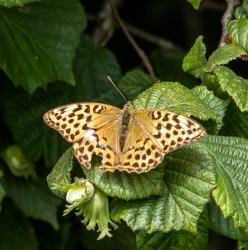 | 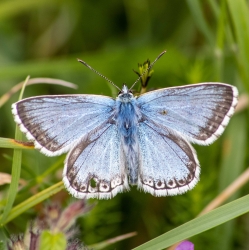 | 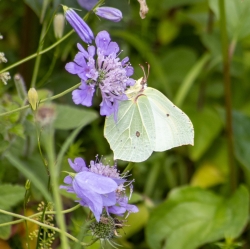 |
| Silver-washed Fritillary female Photo © Francis Plowman | Chalk Hill Blue male Photo © Francis Plowman | Brimstone female on Scabious Photo © Francis Plowman |
Brown Hairstreak on Brook Meadow. Our first sighting on the Brook Meadow reserve in Emsworth Hants SU 7506 [Posted by Brian Fellows]
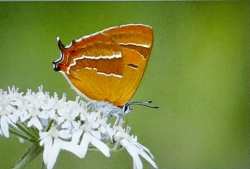 |
| Brown Hairstreak Photo © Brian Fellows |
Bramshill Plantation. Walk round Bramshill Plantation, a new site for me. Highlight was at least four Grayling including a mating pair displaying their upper wings. 16 other species seen with dozens of Gatekeepers and Meadow Browns, a single Brown Argus, Small and Essex Skippers and several Silver-washed Fritillary. [Posted by Paul Warren]
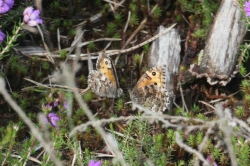 | 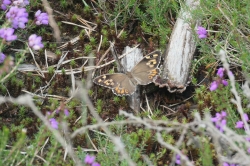 |
| Grayling pair, Bramshill Plantation Photo © Paul Warren | Grayling Bramshill Plantation Photo © Paul Warren |